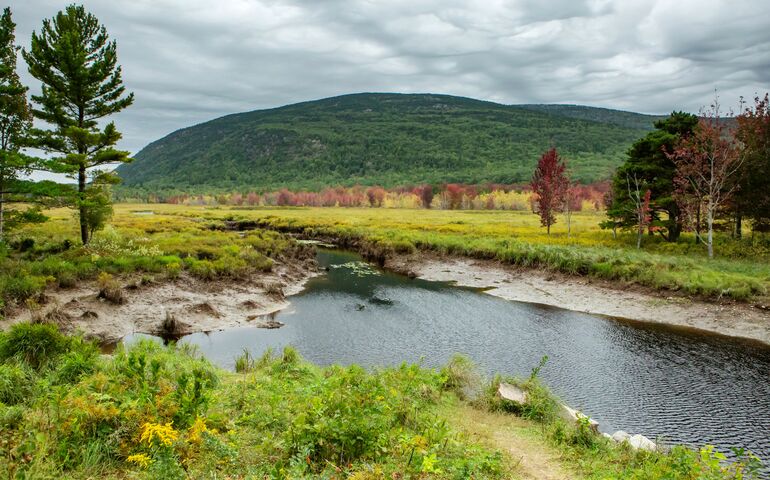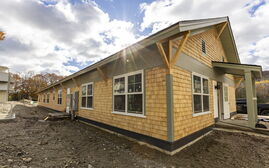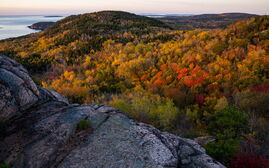$500K project will help restore Acadia National Park wetland
 Courtesy / Ashley L. Conti/Friends of Acadia
Changing leaves are seen at Acadia National Park’s Great Meadow last September.
Courtesy / Ashley L. Conti/Friends of Acadia
Changing leaves are seen at Acadia National Park’s Great Meadow last September.
Thanks to $500,000 in new federal funding, a frequently flooded swath of Acadia National Park will get some shoring up to enhance its ecosystem — and use for recreation.
“It looks beautiful but it’s not in good shape,” Acadia’s chief of natural and cultural resources, Rebecca Cole-Will, told the Acadia National Park Advisory Commission at its triannual meeting last week.
Cole-Will was discussing a 100-acre area called the Great Meadow Wetland, which will receive funding through the Infrastructure Investment and Jobs Act for ecosystem restoration.
The wetland is part of a larger network of wetlands, streams and ponds in a watershed called Cromwell Brook, which includes a popular visitor area called the Tarn.
Great Meadow is Acadia’s largest freshwater wetland and is home to a variety of birds, fish and other animals. It's also a vast recreational attraction for outdoor enthusiasts.
According to the National Park Service, modifications to the area as well as the construction of trails and roads around the time of Acadia National Park’s inception have impaired its ability to act as a wetland and allowed non-native species to thrive instead of freshwater plants.
Problems include an undersized culvert, legacy ditches in the wetland, and an abandoned road that shifted the hydrology and species composition from a healthy wetland complex to a less healthy, low species diversity wetland, according to Friends of Acadia.
The project aims to restore natural water flow and improve trails in the area.
The National Park Service is planning to replace the culvert at the wetland’s outlet with a bridge designed to improve passage for aquatic organisms and to provide the flow capacity needed for larger storm events anticipated because of climate change.
Friends of Acadia is enhancing the park’s work at the Great Meadow by investing in the restoration of the natural stream channel above and below the new bridge. The legacy ditches in the Meadow will be plugged to retain water during high precipitation events, and the abandoned roadbed will be removed to enable natural flow across the wetland.
The improvements are expected to move the Great Meadow closer to the natural hydrology of a wetland complex, help mitigate floods, improve water quality and facilitate greater biodiversity.
Keith Johnston, Acadia’s chief of facility management, said the predesign phase for the project is just about to wrap up.
The problems are not just about individual culvert and ditch fixes, but “fixing landscape scale problems,” said Cole-Will.
“That’s what this funding was targeted for — to improve the functioning, resilience and ecological adaptability of the ecosystem,” she said.
The project leverages partnerships with Friends of Acadia, the Schoodic Institute and the Wabanaki Confederacy, which has offered guidance about approaches at the large landscape scale, she said.
Due to the inadequate size of the culvert and substantial ditching and channelization that has occurred since the park’s founding, the wetland has poor hydrology, loss of species and overall poor quality, Cole-Will said.
“That’s something we don’t see in Acadia’s watershed generally,” she said. “Our wetlands are usually in really good condition. But this one has these issues.”
Other projects
Acadia has other construction projects in the pipeline.
• Through the Infrastructure Investment and Jobs Act, the park received $400,000 to address sea level rise in the Bass Harbor Marsh, a key wetland on Acadia’s southwestern “quiet side.” That work is slated for 2023, said Cole-Will.
The area is the biggest salt marsh in Acadia. The park service has been working with tribal consultants for a number of years to build management relationships for harvesting sweet grass
“But the marsh is threatened by rising sea level, which could change the whole system,” she said.
Another problem, she said, is the substantial number of invasive species that encircle the marsh.
“We’ll continue to work with tribal ethno-botanists and other consultants to think about how to mange that space for the future,” she said.
• A $3.15 million investment is planned for the restoration of Duck Brook Motor Road Bridge, said Johnston. The triple arch bridge, spanning the deep Duck Brook ravine, was constructed in 1950-53 and is the last major bridge constructed in the park as part of the park’s historic motor road. The bridge is hollow and faced with rough-cut granite.
The project includes construction of safety walkways to accommodate regular inspections, masonry repairs to allow for drainage from the roadway, and exterior repointing. The project started earlier this year but will shut down from June 15 to July 15 to accommodate the peak maternity period for bats that roost under the bridge, he said.
• Acadia is in the final stage of legal clearances to open a request for proposals to build a new maintenance facility at the park’s headquarters. The goal is to award a bid in time to start construction this winter or next spring. The job is expected to cost $20 million.














0 Comments